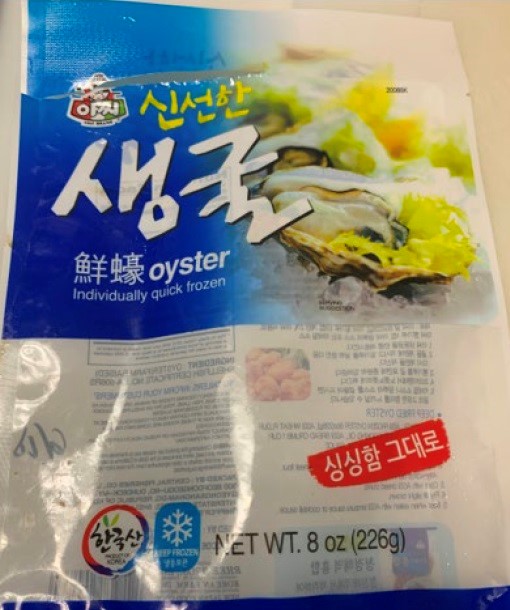The Hawai‘i Department of Health (DOH) Food Safety Branch is notifying the public of the recent Food and Drug Administration (FDA) advisory regarding certain IQF oysters from the Republic of Korea. On June 21, 2024, the FDA cautioned against selling, serving or consuming the oysters, due to potential norovirus contamination.
A product of Central Fisheries Co. Ltd., the oysters of Lot Code # C-20230228 were harvested on Feb. 28, 2023 from Designated Area No. 2, and have a use-by date of Feb. 28, 2025. The oysters were distributed to restaurants and retailers in Hawaiʻi and California, and possibly other states.
The photos below are an example of product labeling from the affected oysters.

Norovirus-contaminated oysters can cause illness to consumers of all ages if eaten, and potentially severe illness in people with compromised immune systems. Foods containing norovirus may look, smell, and taste normal. Consumers experiencing symptoms should contact their health care provider and are encouraged to report any suspected illness related to this recall to the DOH Disease Reporting Line at 808-586-4586.
Symptoms of Norovirus
The most common symptoms of norovirus are diarrhea, vomiting, nausea, and stomach pain. Other symptoms include fever, headache, and body aches.
A person usually develops symptoms 12 to 48 hours after being exposed to norovirus. Most people with norovirus illness get better within one to three days.
Norovirus illness can cause vomiting and diarrhea severe enough to cause dehydration, especially in young children, older adults, and people with other illnesses. Symptoms of dehydration include a decrease in urination, a dry mouth and throat, and dizziness when standing up. Dehydrated children may cry with few or no tears and be unusually sleepy or fussy.
If you think you or someone you are caring for is severely dehydrated, call your health care provider.
Recommendations for Restaurants and Retailers
Restaurants and retailers should not serve or sell the potentially contaminated oysters. They should dispose of the affected products or return them to their distributor for destruction.
Restaurants and retailers should also be aware that shellfish may be a source of pathogens and should control the potential for cross-contamination of the food-processing equipment and environment. They should follow the steps below:
- Wash hands with warm water and soap following the cleaning and sanitation process.
- Retailers, restaurants, and other food service operators who have processed and packaged any potentially contaminated products should practice regular frequent cleaning and sanitizing of food contact surfaces and food preparation utensils to help minimize cross-contamination.
- Retailers that have sold bulk product should clean and sanitize all containers used to hold the product.
On June 13, the Hawaiʻi DOH advised the FDA of an outbreak of norovirus illnesses associated with the consumption of the affected oysters.
On June 19, 2024, the ROK advised the FDA that Central Fisheries Co., LTD voluntarily recalled the affected oysters.
The FDA will continue to monitor the investigation and assist state authorities as needed. As new information becomes available, the FDA will update the safety alert.
The DOH Food Safety Branch protects and promotes the health of Hawai‘i residents and visitors through education of food industry workers and regulation of food establishments statewide. The branch conducts routine health inspections of food establishments where food products are prepared, manufactured, distributed, or sold.
The branch also investigates the sources of foodborne illnesses and potential adulteration; and is charged with mitigating the effects of these incidents to prevent any future occurrences. Department of Health food safety specialists strive to work with business owners, food service workers, and the food industry to ensure safe food preparation practices and sanitary conditions.